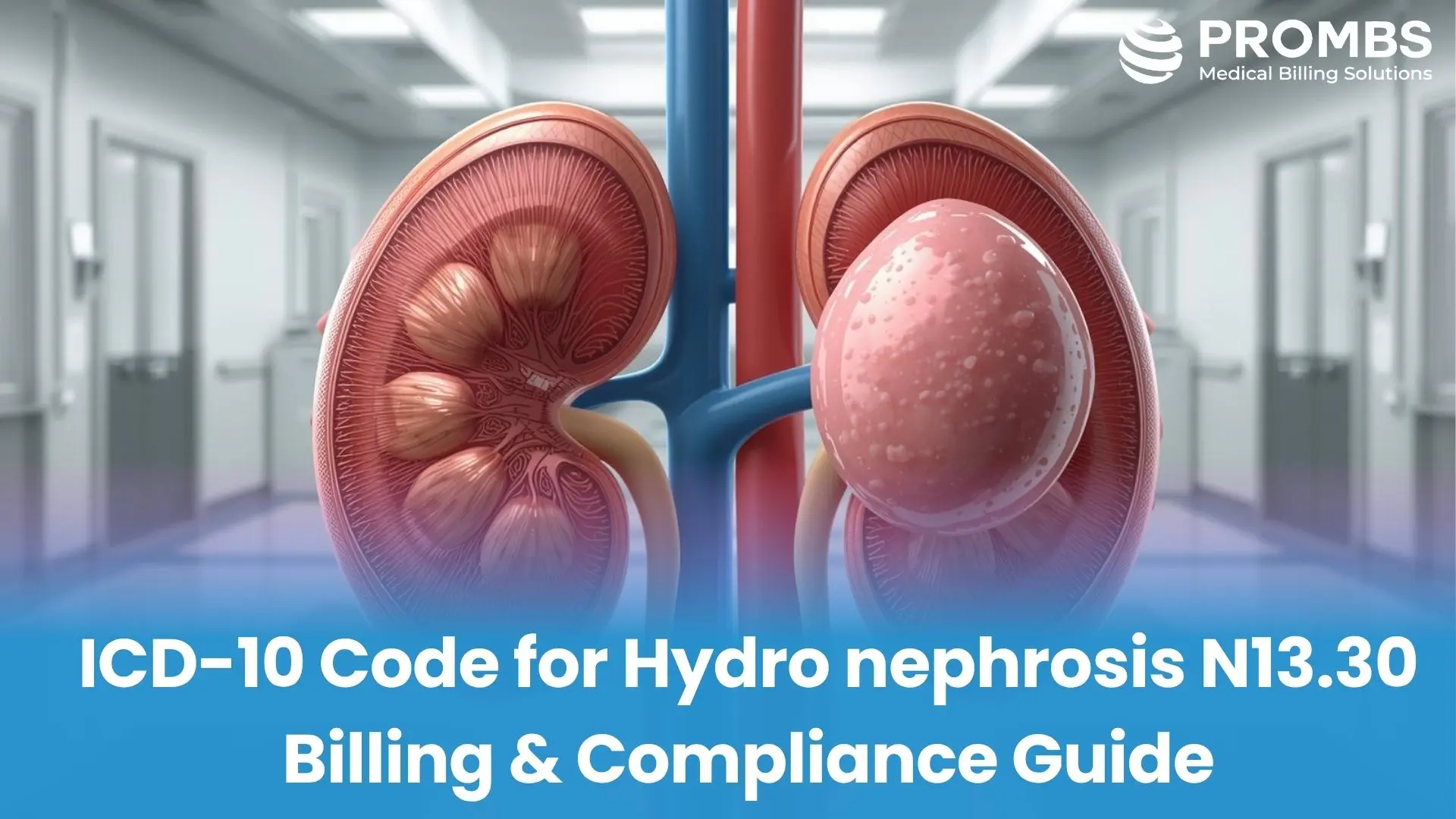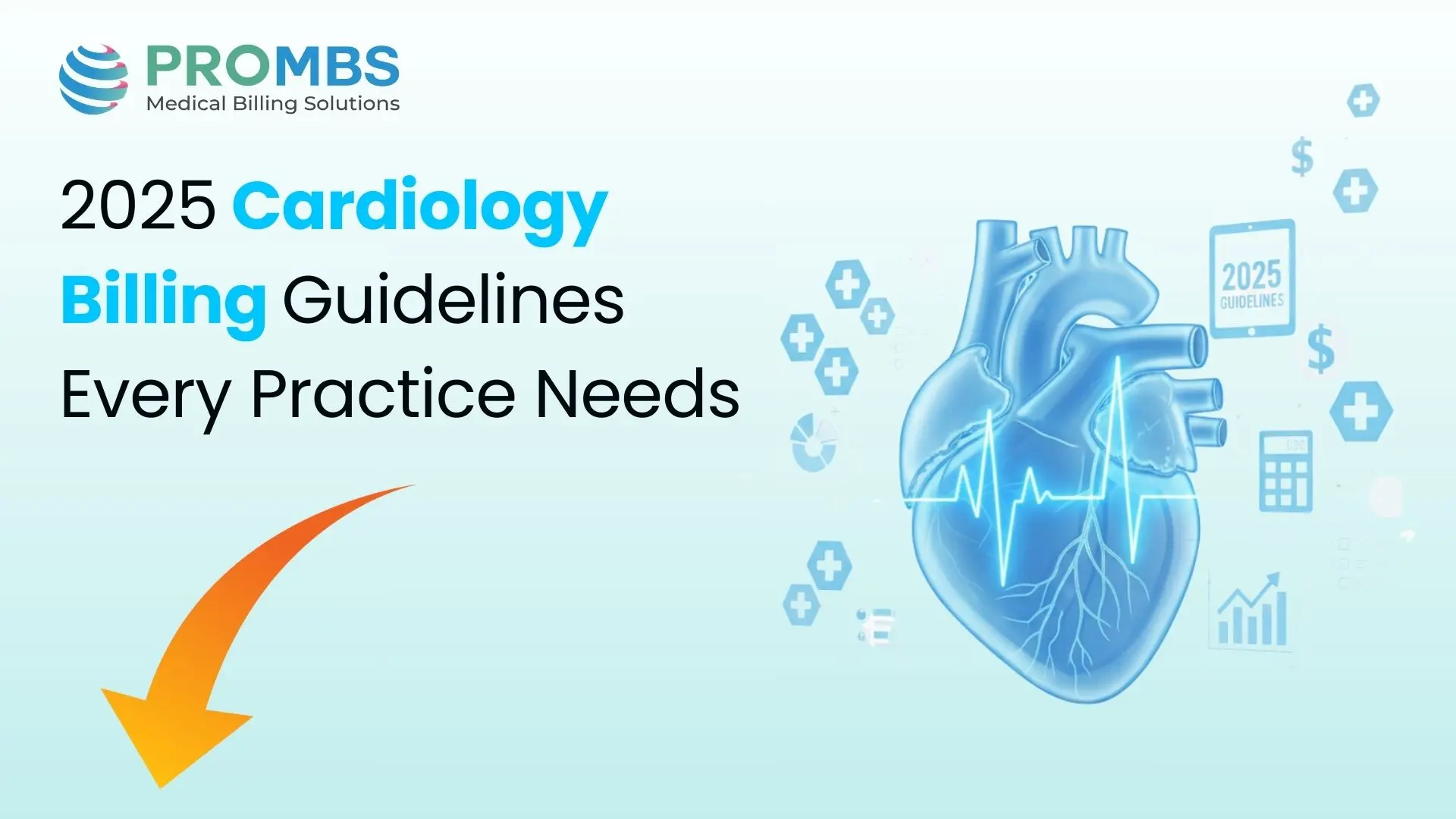Hydronephrosis, a condition where urine backs up into the kidney causing swelling — is clinically significant because it can lead to renal damage if not treated properly. From a billing standpoint, hydronephrosis is a high-cost, high-denial risk condition. According to the National Institute of Diabetes and Digestive and Kidney Diseases (NIDDK), it can occur due to kidney stones, congenital defects, tumors, or pregnancy-related obstruction.
For coders, the icd 10 code for hydronephrosis is frequently used in urology, nephrology, emergency care, and inpatient hospital claims. Improper documentation of laterality (left vs right kidney), underlying cause (stone, stricture, tumor), or whether the obstruction is acute vs chronic can trigger payer denials. The CMS ICD-10 guidelines stress that specificity in hydronephrosis coding is necessary to align medical necessity with services like CT scans, stent placement, or surgical procedures.
What Is Hydronephrosis and What Are Its Symptoms?
Hydronephrosis is a condition where urine builds up inside the kidney due to obstruction or impaired drainage, causing the renal pelvis to swell. It is not a primary disease but rather a secondary manifestation of urinary tract obstruction, which may result from kidney stones, strictures, tumors, or congenital abnormalities. According to the National Institute of Diabetes and Digestive and Kidney Diseases (NIDDK), hydronephrosis can be unilateral (one kidney) or bilateral (both kidneys), with severity ranging from mild dilation to irreversible kidney damage.
Clinically, many cases of hydronephrosis may remain silent and asymptomatic, especially if mild. However, as the obstruction worsens, patients typically present with a spectrum of symptoms that coders must ensure are clearly documented, since they directly support medical necessity for diagnostics, procedures, and the correct icd 10 code for hydronephrosis.
Common Symptoms Documented in Hydronephrosis Cases:
| Symptom | Clinical Presentation | Coding Relevance |
|---|---|---|
| Flank Pain | Sharp or dull pain in the back or side, often radiating to the lower abdomen. The Cleveland Clinic notes flank pain as the most frequent presenting symptom. | Strongly supports hydronephrosis diagnosis; must be linked in documentation when billing imaging CPT codes like CT abdomen (74176) or ultrasound (76770). |
| Nausea and Vomiting | Often due to acute obstruction (e.g., ureteral stone). Documented in NIDDK guidance. | Helps demonstrate medical necessity for ED visits (99283) and hydration therapy (96360). |
| Hematuria | Visible or microscopic blood in urine, common with stone-related hydronephrosis. | Pairs with hydronephrosis codes such as N13.30 (unspecified) or N13.31/N13.32 (with stricture). Supports lab CPT codes like urinalysis (81001). |
| Recurrent UTIs | Frequent urinary tract infections due to urine stasis. The CDC reports UTIs as one of the most common bacterial infections worldwide. | Chronic hydronephrosis with UTI complications requires dual coding (hydronephrosis + N39.0 recurrent UTI). |
| Fever/Sepsis | Indicates infection due to obstruction, a medical emergency. | Requires linking hydronephrosis ICD-10 codes with sepsis codes (A41.x) for accurate claim support in inpatient billing. |
| Asymptomatic Cases | Often discovered incidentally on imaging, especially in prenatal ultrasounds. | Coders must still capture hydronephrosis with the correct code (e.g., N13.0 UPJ obstruction) even without symptoms, per CMS ICD-10 guidelines. |
Did You Know? According to a Journal of Urology study, hydronephrosis is found in nearly 3% of prenatal ultrasounds, making it one of the most frequently diagnosed urologic conditions before birth. This high detection rate explains why the icd 10 code for hydronephrosis is widely used in both pediatric and adult billing claims.
The ICD-10 Code for Hydronephrosis
The primary icd 10 code for hydronephrosis is N13.30-Unspecified hydronephrosis. However, ICD-10 offers multiple subcodes to capture laterality and cause are mentioned in the table below. According to ICD10Data, each subcategory adds critical detail that insurers review for approval of imaging or surgical procedures. Using N13.30 when the provider documented laterality can lead to denials. The icd 10 code for hydronephrosis is not a single code but a group of diagnosis codes under the N13 category: Obstructive and reflux uropathy. The most commonly used is N13.30- Unspecified hydronephrosis, which is applied when a provider documents hydronephrosis but does not specify laterality (right, left, bilateral) or underlying cause.
However, relying on N13.30 too frequently can create billing problems. The CMS ICD-10-CM Guidelines emphasize that coders must always report the highest specificity possible. If documentation supports more detail, such as a ureteropelvic junction obstruction (N13.0) or laterality with stricture (N13.31 right, N13.32 left), then coders should not default to N13.30. The World Health Organization (WHO) categorizes hydronephrosis under genitourinary system diseases-Chapter XIV, highlighting it as a complication of obstructive uropathy. Using the correct code ensures proper clinical communication and also prevents denials when CPT procedures such as nephrostomy insertion (50393) or ureteral stent placement (52005) are billed.
| ICD-10 Code | Meaning | Example Clinical Documentation |
|---|---|---|
| N13.30 | Unspecified hydronephrosis, as explained in the WHO ICD-10 index. | “Hydronephrosis detected on CT, laterality not specified.” |
| N13.31 | Hydronephrosis with ureteral stricture, right side. | “Right-sided hydronephrosis due to ureteral narrowing.” |
| N13.32 | Hydronephrosis with ureteral stricture, left side. | “Left hydronephrosis caused by ureteral stone-induced stricture.” |
| N13.0 | Hydronephrosis with ureteropelvic junction (UPJ) obstruction, detailed by WHO. | “Congenital UPJ obstruction causing hydronephrosis in a child.” |
| N13.7 | Vesicoureteral reflux with hydronephrosis. | “Bilateral hydronephrosis with reflux confirmed on VCUG.” |
Did You Know? The Office of Inspector General (OIG) has flagged unspecified ICD-10 codes like N13.30 among the most common contributors to improper Medicare payments. Coders who consistently default to “unspecified hydronephrosis” when the provider has documented laterality or cause increase the risk of denials and audits. Correctly distinguishing between N13.30, N13.31/N13.32, and N13.0 not only improves compliance but also ensures CPT services (such as stent placement or nephrostomy insertion) are reimbursed.
Which ICD-10 Chapter Includes Hydronephrosis?
Hydronephrosis belongs to Chapter XIV: Diseases of the Genitourinary System (N00–N99). Within this chapter, hydronephrosis is listed under N13-Obstructive and reflux uropathy. The CMS ICD-10-CM Guidelines emphasize that coders must follow Excludes notes to avoid coding hydronephrosis along with mutually exclusive diagnoses like acute pyelonephritis.The icd 10 code for hydronephrosis belongs to Chapter XIV: Diseases of the Genitourinary System (N00–N99). This chapter covers conditions affecting the kidneys, ureters, bladder, and male and female reproductive systems. Within it, hydronephrosis is categorized under the N13 block: Obstructive and reflux uropathy.
As the CMS ICD-10-CM Official Guidelines explain, coders must carefully follow chapter-specific rules, including Excludes1 and Excludes2 notes, to avoid coding conflicts. For example, hydronephrosis (N13 codes) should not be coded alongside acute pyelonephritis (N10) unless both are clearly documented as coexisting conditions.The World Health Organization ICD-10 browser also places hydronephrosis within the N13 category, emphasizing its relationship to obstruction and reflux pathologies. This structure ensures coders capture not only the diagnosis but also its underlying pathophysiology.
| ICD-10 Chapter | Code Range | Where Hydronephrosis Fits | Coding Insight |
|---|---|---|---|
| Chapter XIV: Diseases of the Genitourinary System | N00–N99 | Covers all kidney, urinary tract, and reproductive system disorders, as outlined in CMS guidelines. | Hydronephrosis is grouped here because it reflects a kidney disorder secondary to urinary obstruction. |
| Block N13: Obstructive and Reflux Uropathy | N13.0–N13.9 | Includes hydronephrosis codes such as N13.30 (unspecified), N13.31 (right side), N13.32 (left side), N13.0 (UPJ obstruction), and N13.7 (vesicoureteral reflux with hydronephrosis). Verified in WHO ICD-10 browser. | This block distinguishes hydronephrosis based on cause and laterality, which is essential for medical necessity and CPT linkage. |
| Specific Codes Under N13 | N13.0, N13.30, N13.31, N13.32, N13.7 | Capture the exact form of hydronephrosis. For instance, N13.31 = right-sided hydronephrosis due to ureteral stricture. | Choosing the most specific code reduces denial risk and ensures accurate alignment with CPT procedures like nephrostomy insertion (50393) or cystoscopy (52005). |
Did You Know? According to the Agency for Healthcare Research and Quality (AHRQ), hospitalizations for obstructive uropathy, including hydronephrosis, account for tens of thousands of admissions each year in the U.S.. Incorrectly coding hydronephrosis under a nonspecific chapter or using unspecified codes like N13.30 significantly contributes to billing denials and improper Medicare payments flagged by the OIG.
Which CPT Codes Pair with the ICD-10 Code for Hydronephrosis?
The icd 10 code for hydronephrosis must always be paired with the appropriate CPT codes that reflect the diagnostic or therapeutic services performed. ICD-10 codes explain why a service was necessary, while CPT codes describe what was done. Payers require these pairings to prove medical necessity.
As the AMA CPT guidelines explain, hydronephrosis often requires diagnostic imaging (ultrasound, CT, urography) and interventions (stent placement, nephrostomy tube, surgery). Claims are frequently denied when documentation does not clearly link the CPT service to the correct hydronephrosis code, especially when laterality (right vs left) or underlying cause is missing.
| CPT Code | Description | Typical ICD-10 Pairing | Documentation Tip |
|---|---|---|---|
| 50393 | Insertion of nephrostomy catheter, percutaneous, explained in AMA CPT guidance. | Commonly paired with N13.30 (unspecified hydronephrosis) or N13.0 (hydronephrosis with UPJ obstruction) when drainage is necessary. | Provider must document obstruction and hydronephrosis severity. Using unspecified code N13.30 when laterality is available can lead to denials. |
| 74420 | Urography, retrograde with imaging, detailed by the RadiologyInfo resource. | Paired with N13.0 when hydronephrosis is caused by ureteropelvic junction obstruction. | Imaging report must specify the obstruction and its anatomical site. |
| 52005 | Cystourethroscopy with ureteral catheterization, defined in AMA CPT coding rules. | Paired with N13.31 (right hydronephrosis with stricture) or N13.32 (left hydronephrosis with stricture). | Documentation must capture laterality and obstruction type to justify pairing. |
| 74176 | CT abdomen and pelvis without contrast, described in ACR Appropriateness Criteria. | Used with hydronephrosis codes such as N13.30 to confirm obstruction. | Radiology report must explicitly mention hydronephrosis; otherwise payers may deny medical necessity. |
| 99283 | Emergency department visit, low to moderate severity, according to AMA E/M guidelines. | Linked with hydronephrosis when patient presents with acute flank pain and urinary obstruction. | Documentation should tie presenting symptoms (pain, hematuria, infection) to the diagnosis of hydronephrosis. |
What Are the Treatments for Hydronephrosis?
Treatment of hydronephrosis depends on its severity, cause, and whether one or both kidneys are involved. In mild cases, hydronephrosis may resolve spontaneously, while severe obstruction can progress to kidney damage or failure if left untreated. The National Kidney Foundation emphasizes that untreated hydronephrosis can result in loss of kidney function, making timely intervention critical both clinically and for medical billing compliance. For coders and billers, every treatment step must be properly tied to the icd 10 code for hydronephrosis (N13.30 and related subcodes) and the CPT codes describing what was done. Payers often deny claims when documentation does not link the clinical findings to the necessity of a diagnostic test or therapeutic procedure.
| Treatment Type | Clinical Application | ICD-10 Example | CPT Example | Documentation Insight |
|---|---|---|---|---|
| Observation & Monitoring | Used in mild or prenatal hydronephrosis cases that resolve without intervention, as noted by the Cleveland Clinic. | N13.30 (unspecified hydronephrosis). | 99213 (office visit). | Providers must document follow-up imaging and resolution status to justify ongoing monitoring. |
| Ureteral Stent Placement | Relieves obstruction by keeping the ureter open. Common in stone-related hydronephrosis. | N13.31 (right hydronephrosis with stricture). | 52005 (cystourethroscopy with catheterization). | Must capture laterality and stricture location in the operative note. |
| Percutaneous Nephrostomy | Insertion of tube into kidney for drainage, described in AMA CPT guidance. | N13.0 (UPJ obstruction with hydronephrosis). | 50393 (insertion of nephrostomy catheter). | Imaging report and procedure note must clearly state obstruction and hydronephrosis severity. |
| Surgery (Pyeloplasty) | Surgical repair of UPJ obstruction, common in congenital cases. | N13.0 (hydronephrosis with UPJ obstruction). | 50400 (open pyeloplasty). | Surgeon must document anatomical abnormality and corrective procedure performed. |
| Antibiotic Therapy | Used when hydronephrosis is complicated by infection, as explained by the NIDDK. | N13.7 (vesicoureteral reflux with hydronephrosis). | 96365 (IV infusion of therapeutic antibiotics). | Link infection diagnosis (UTI or sepsis) to hydronephrosis in the record for compliance. |
Did You Know? A study published in the Journal of Urology found that hydronephrosis is one of the leading reasons for emergency urologic admissions, with obstructive stones accounting for more than 60% of acute presentations. This high prevalence underscores why the icd 10 code for hydronephrosis and linked CPT services are among the most closely reviewed in payer audits. Incorrectly coded hydronephrosis claims frequently appear in OIG audit reports as examples of improper Medicare payments.
How Should Documentation Be Structured to Avoid Denials?
Hydronephrosis is one of the most commonly denied urology claims when documentation is vague, incomplete, or inconsistent. Payers such as CMS and commercial insurers carefully review hydronephrosis claims to ensure that the diagnosis code, procedure, and medical necessity align. To avoid denials, providers must structure documentation logically, ensuring that symptoms → findings → diagnosis → treatment all connect clearly. As the AAPC explains, demonstrating medical necessity is the single most effective way to secure clean claims.
| Documentation Pitfall | Why It Causes Denials | Best Practice Example |
|---|---|---|
| “Hydronephrosis present.” | Too vague; payers cannot validate medical necessity for procedures like nephrostomy insertion. | “Right hydronephrosis (N13.31) secondary to ureteral stricture confirmed on CT; nephrostomy catheter placed (CPT 50393).” |
| Laterality missing. | Insurers deny unspecified codes if side is documented elsewhere. | “Left-sided hydronephrosis (N13.32) due to impacted ureteral stone; cystoscopy with stent performed (CPT 52005).” |
| Linking only CPT without ICD-10. | Medical necessity is not established without diagnosis connection. | “Patient admitted with hydronephrosis due to UPJ obstruction (N13.0); open pyeloplasty performed (CPT 50400).” |
| Using N13.30 when detail exists. | Viewed as coding error; flagged in audits by OIG. | Always code to specificity: e.g., “Hydronephrosis with vesicoureteral reflux (N13.7)” when reflux is documented. |
Did You Know? The Office of Inspector General (OIG) has repeatedly flagged unspecified hydronephrosis codes like N13.30 as contributors to Medicare overpayments. In many cases, the detail (laterality or cause) was present in the provider’s notes but never coded. This small oversight led to denials, recoupments, and compliance risk. Ensuring that documentation captures laterality, cause, severity, and procedure linkage can dramatically reduce denials and protect providers from audits.
Why Should Providers Partner with PROMBS for Hydronephrosis Billing?
Hydronephrosis claims are high-stakes because they frequently involve expensive imaging, surgical procedures, and hospital admissions. Even small documentation gaps, such as missing laterality or coding unspecified hydronephrosis with N13.30 when detail is available, can result in costly denials, payer audits, or delayed reimbursement. According to CMS improper payment data, improper claims across Medicare still represent more than $31 billion annually, with urology and nephrology services repeatedly flagged for coding and documentation errors. This is where PROMBS becomes a trusted partner. Our team specializes in nephrology and urology billing, ensuring that every hydronephrosis claim is accurate, compliant, and revenue-optimized.



